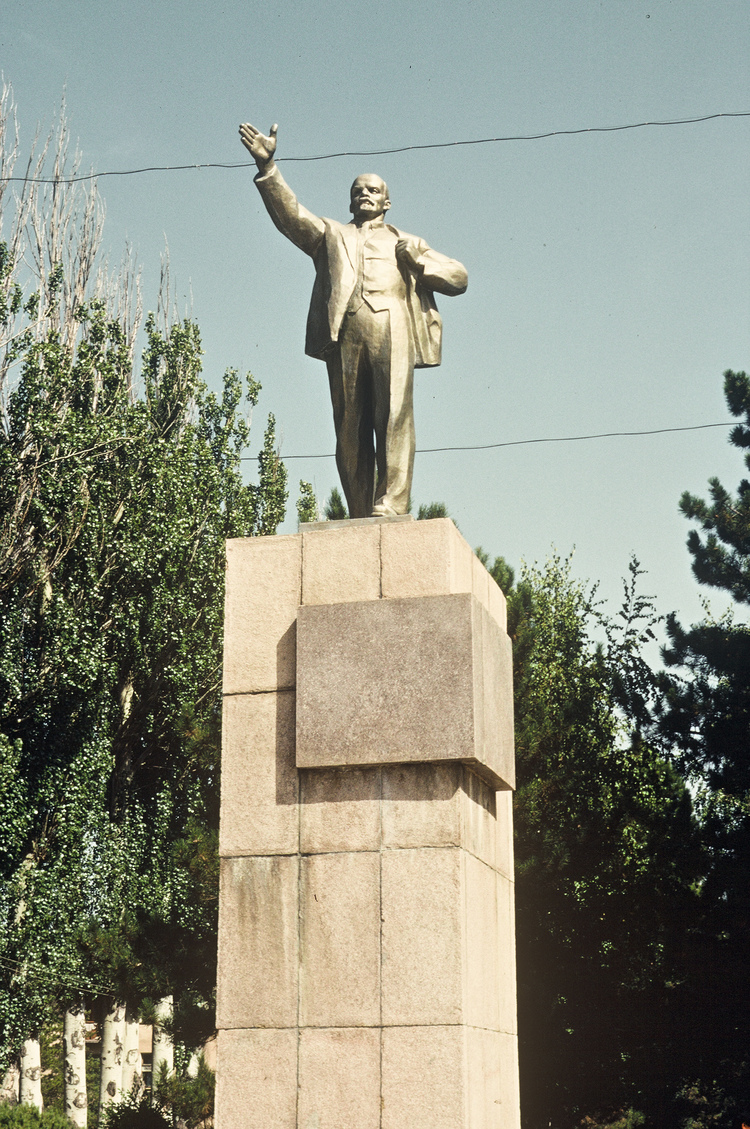From the so-called Pamir Knot in Tajikistan, the great mountain ranges of Asia extend in all directions—the Himalayas and the Karakoram to the southeast, the Hindu Kush to the southwest, the Kunlun to the east, and the Tian Shan to the northeast. In Kyrgyzstan, the Central Tian Shan range forms a natural border with China’s Xinjiang Province, rising to Pik Pobedy (Victory), at 24,111 feet the second-highest point in the former Soviet Union.
The Kyrgyz Ala Too range rises south of Bishkek
South of Bishkek, the Kyrgyz Ala Too range runs east-west to the deep mountain lake of Issyk-Kul; the Kungey Ala Too range north of the lake forms the border with Kazakhstan; the Fergana range straddles the middle of the country; the Pamir Alay range dominates the south. More than 90 per cent of Kyrgyzstan’s land area—the size of Austria and Hungary combined, or the U.S. state of Montana—consists of mountains, with 40 per cent over 3,000 feet.
Postcards from Stanland: Journeys in Central Asia (Ohio University Press, 2016) is available from Amazon, Barnes & Noble, Books-a-Million and other online retailers. Read excerpts at www.davidhmould.com (Travel Blogs) or Facebook /PostcardsFromStanland/ or view readings and interviews on YouTube
The mountains are both a blessing and a curse. Their natural beauty offers potential for tourism, but “Switzerland of Asia” campaigns have so far failed to contribute significantly to the economy, mainly because of the remoteness of the country and poor roads and tourist facilities. It’s great trekking terrain, but the so-called resorts—most of them former summer camps for Soviet industrial workers—are short on both modern facilities and après-ski ambience. There are mineral deposits, many of them unexploited because of the cost and difficulty of mining in remote regions. Hydro-electric plants have the potential provide all the country’s electricity supply, and some for export. However, as the glaciers continue to recede, scientists worry about the sustainability of the country’s water resources. For centuries, the mountains have provided summer pastures for herds of sheep, goats and horses, but most of the land cannot be cultivated.
On the road from Bishkek to Osh
Few roads cross the mountains, and they are often blocked by avalanches and mudslides; cash-strapped local authorities struggle to maintain or improve them. Building new roads to improve commerce and boost the economy in rural areas means moving massive quantities of earth and rock and constructing bridges and tunnels—a major investment that usually requires help from foreign donors. It is difficult and expensive to transport goods, deliver the mail, or provide medical services; in winter, a trip to the town market or the hospital may be impossible. At higher elevations, the first snows come in October; some settlements are cut off from November to May.
The mountains are as much a cultural and political as a physical barrier. The major concentrations of population are in two large valleys—the Chuy in the north, with the capital Bishkek, and the Fergana in the south, with Osh and Djalalabad, the second and third largest cities. About half the country’s population of 5.3 million live in the south. The Ala-Too and Fergana ranges separate the valleys, splitting the country and its major urban centers into two distinct regions. In Kyrgyz society, where identity and loyalty are still defined by family, clan, and village, the government in Bishkek can seem very distant. The north is more industrialized and secular, oriented to Kyrgyzstan’s larger and more prosperous Central Asian neighbor, Kazakhstan, and to Russia and the West. The south is more agricultural, conservative and Islamic, looking to Uzbekistan and further west to Iran. Some northerners fear separatism, Islamic fundamentalism and the influence of Uzbekistan in the south; some southerners believe the government in Bishkek exploits their region, while short-changing it on tax revenue and social services. Polls show that most people in Kyrgyzstan consider the differences between the north and south to be the major challenge to national unity.






